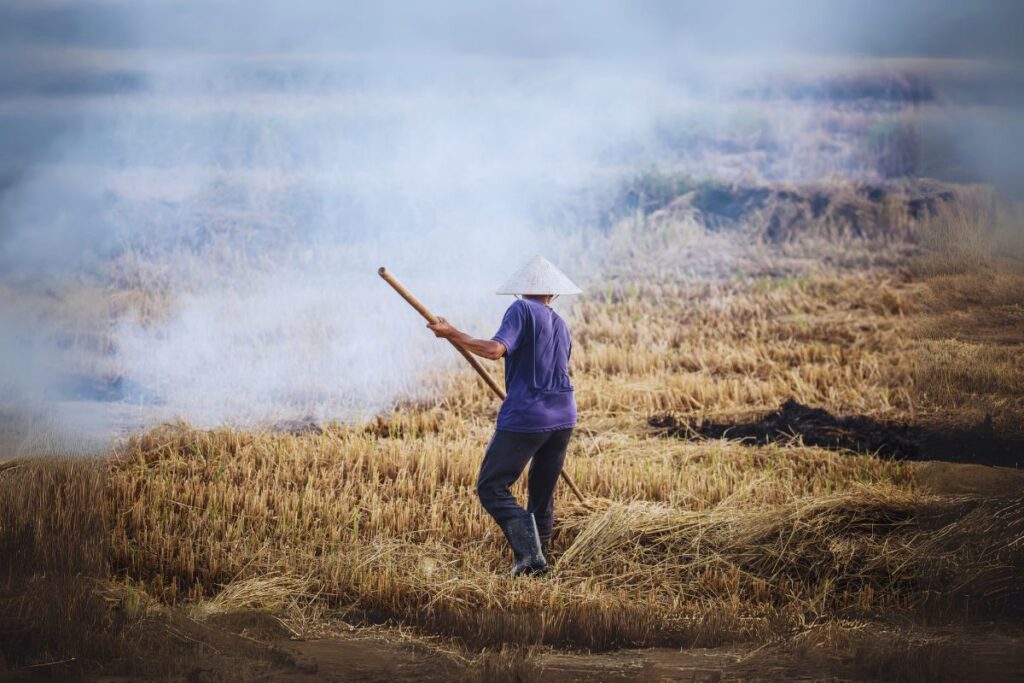To be able to clear their fields after harvest, farmers in North India burn leftover straw, a technique known as crop burning. Even though financial factors drive this approach, it dramatically worsens the air pollution problem, particularly in urban areas.
Health Risks Associated with Crop Burning
Burning crops generate smoke, full of hazardous chemicals such as particulate matter, nitrogen oxides, carbon monoxide, and volatile organic compounds (VOCs). According to research by Sharma et al. (2021) published in Environmental Research, inhaling the smoke from burning crops is directly associated with respiratory issues, heart conditions, and worsened symptoms of asthma.
Statistics:
The Ministry of Earth Sciences reports that in October 2020, Delhi’s air pollution levels were about 40% caused by stubble burning, which resulted in a 20% spike in hospital admissions for respiratory illnesses. According to the Central Pollution Control Board (CPCB), the peak crop burning season saw an abrupt rise in respiratory disease cases.
1. Respiratory Health: Breathing in particulate matter from burning crops can cause asthma, bronchitis, and chronic obstructive pulmonary disease (COPD). According to an analysis published in the International Journal of Environmental Health Research in 2022, people exposed to high PM2.5 levels are far more likely to suffer from respiratory conditions.
2. Cardiovascular Health: Research indicates that long-term exposure to particulate matter can lead to cardiovascular diseases. A study published in Circulation (2023) shows that exposure to PM 2.5 increases the risks of hypertension, heart attacks, and strokes. The inflammatory response caused by inhaling pollutants can cause arterial damage and increase the risk of cardiovascular events.
3. Neurological Effects: Children’s cognitive impairment and neurodevelopmental abnormalities are associated with exposure to air pollution, particularly emissions from burning crops, according to a study by Calderón-Garcidueñas et al. (2023) published in Environmental Health Perspectives. Inhaling harmful particles can trigger neuroinflammatory processes, which may contribute to many disorders.
4. Skin Health: Increased particulate matter and other pollutants may cause skin conditions like dermatitis and eczema, and contaminants may be able to get through the skin barrier, causing irritation and inflammation, according to a paper published in the American Journal of Dermatology in 2022.
Symptoms: Red Flags to Watch For
● The following symptoms should be watched for by anyone exposed to smoke from burning crops:
● Respiratory: Breathlessness, wheezing, a chronic cough, and chest pain are all signs of acute respiratory distress or a worsening of long-term lung diseases.
● Cardiovascular: Especially for those with a history of heart illness, chest pain, palpitations, or unusual exhaustion should require rapid medical attention.
● Neurological: Impaired concentration, disorientation, or memory loss could be signs of cognitive decline or other neurological problems.
● Skin problems: rashes, increased irritation, and the formation of new lesions.
Prevention: How to Minimize Exposure
To reduce exposure to crop-burning smoke, consider the following strategies:
1. Stay Indoors: Stay indoors with windows closed when you notice poor air quality, especially after Diwali when the gloominess of smog takes over to limit exposure to outdoor pollutants.
2. Use Air Purifiers: High-efficiency particulate air (HEPA) filters can significantly reduce indoor pollution. Regularly maintain air purifiers to ensure their effectiveness.
3. Wear masks: wearing masks that filter out particulate matter can help protect your respiratory health when you’re out for something.
4. Advocate for Sustainable Practices: Supporting local initiatives that promote sustainable farming practices and using technology to manage crop residues can help reduce the reliance on burning.
Conclusion
Crop burning continues to be a serious threat to public health. It’s a necessity to understand the possible risks this activity bring with itself in order to protect our own health and increase community awareness. HealthPil is committed to helping consumers find medical professionals for evaluations and treatment related to air pollution exposure.
Disclaimer
This article is for informational purposes only and should not be considered a substitute for professional medical advice.
References
- Sharma, M., et al. (2021). “Health Impact of Crop Residue Burning on Respiratory Health: A Review.” Environmental Research, 198, 111158.
- Ministry of Earth Sciences, Government of India. (2020). “Assessment of Air Quality Due to Crop Burning.”
- Central Pollution Control Board. (2021). “Impact of Stubble Burning on Air Quality in Delhi.”
- Calderón-Garcidueñas, L., et al. (2023). “Air Pollution and Its Implications for Neurodegenerative Diseases.” Environmental Health Perspectives, 131(5), 057005.
- American Journal of Dermatology. (2022). “The Impact of Environmental Pollutants on Skin Health.”

